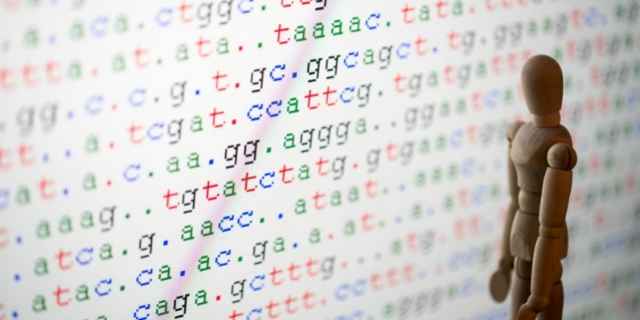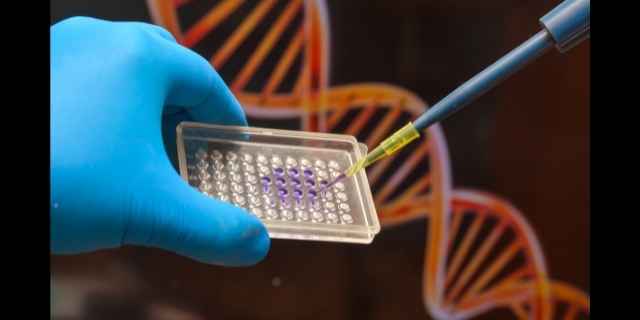DNA sequencing refers to any technique that identifies the sequence in which the basic building blocks of a DNA sample appear.
The building blocks are four types of molecules called nucleotides: A, C, T, and G. DNA sequencing determines their order.
The latest techniques are called Next Generation Sequencing or NGS.
So, what is NGS? And what came before the next generation?
What Was The First Type Of DNA Sequencing?

Allan Maxam and Walter Gilbert worked together in the 1970s on a method that involved breaking a DNA sample into small chunks.
There are certain chemicals that break DNA at specific nucleotides. One will cleave the DNA at a G nucleotide while another only breaks it at an A nucleotide.
The general idea was to dunk the sample into four reaction tubes containing four different chemicals and see what fragments emerged.
Maxam-Gilbert sequencing
This method was called the Maxam-Gilbert Sequencing and it was very popular when first introduced. However, it also had big problems.
Firstly, it took a lot of time to sequence a small piece of DNA. Basically, a lab could get through about 100 bases a day.
Secondly, the process needed a lot of radiation which brought its own hazards.
This meant that when a different technique showed up that was faster and safer, everybody switched over. That technique was widely used for another forty years.
I’m talking about Sanger Sequencing.
What Is Sanger Sequencing?
Frederick Sanger, an English biochemist, developed a highly accurate method in 1977. It involves several steps.
The DNA sample is mixed with several other ingredients including four different colors of die. Each color corresponds to the A, C, T, or G nucleotide.
The mix is sent through a process that binds the colored dies to specific nucleotides. The DNA sample is then loaded onto a gel.
If the process is done manually, the scientist reads the colors on the gel to figure out the A/C/T/G/ sequence.
An automated process uses a laser to light up the different colors for detection by a machine.
By convention, A is indicated by green fluorescence, T by red, G by black, and C by blue.

What Are The Drawbacks Of Sanger Sequencing?
Sanger sequencing is still widely used in labs today. So, why did we need a new generation of sequencing techniques?
Well, the technique is cheaper and less time-consuming than the Maxam-Gilbert method that we looked at first. But more recent techniques are much faster on higher volumes of DNA.
And there is one specific disadvantage to the technique.
I mentioned that the sample is mixed with other chemicals. At an early stage, a primer binds to the starting section of the sample. The quality of the sequencing degrades in that section.
The quality also declines after about nine hundred bases. This means that it is best used for small fragments of DNA.
Having said that, Sanger Sequencing was used in the Human Genome Project that started in 1990. The HGP took thirteen years and three billion dollars to sequence our entire DNA.

It was an extraordinary effort, but biotech companies embarked on a race for faster and cheaper methods.
This is where Next Generation Sequencing comes in.
What Is Next Generation Sequencing?
Next Generation Sequencing refers to running sequencing methods in parallel across many fragments of DNA.
This means that one run of sequencing can operate on millions of fragments. This massively increases the amount of DNA that can be sequenced in a short term.
The first step involves isolating high-quality nucleic acids from the DNA sample.
Libraries
The next step is to prepare what’s known as a library of these nucleic acids to work with.
This involves breaking the sample into many small fragments and attaching nucleotides called “adapters” to their ends.
Amplification
The next step is amplification.
This means that each fragment clones to become a cluster of identical molecules. This ensures that their signals are strong enough to be detected in a later step.
Now, different colored fluorescent molecules are introduced to the process. Each of the four different types corresponds to one of the A, C, T, and G nucleotides.
A single cycle adds one of the fluorescent molecules to a cluster and washes away the dies that don’t bind.
The process takes an image that captures the location of the remaining dye.
Then the dye and the cluster are separated and the next cycle begins.
At the end of many cycles, there is a huge amount of sequencing data to be processed. This is done with highly powerful computers.
Do Consumer DNA Tests Use Sequencing?
Have you tested your DNA with Ancestry.com, 23andMe, or MyHeritage?
You may be wondering if these companies use DNA sequencing to analyze your entire DNA sample.
The popular DNA tests are around or under one hundred bucks. This doesn’t pay (yet) for extensive DNA sequencing.
Instead, the consumer DNA tests use a technique known as genotyping. You can learn more in our article that explains genotyping in simple terms.